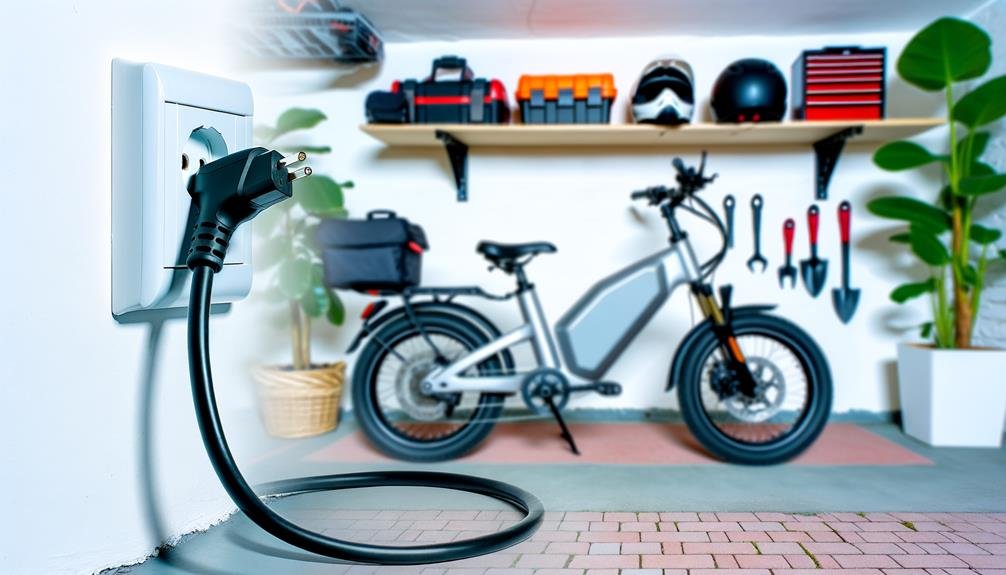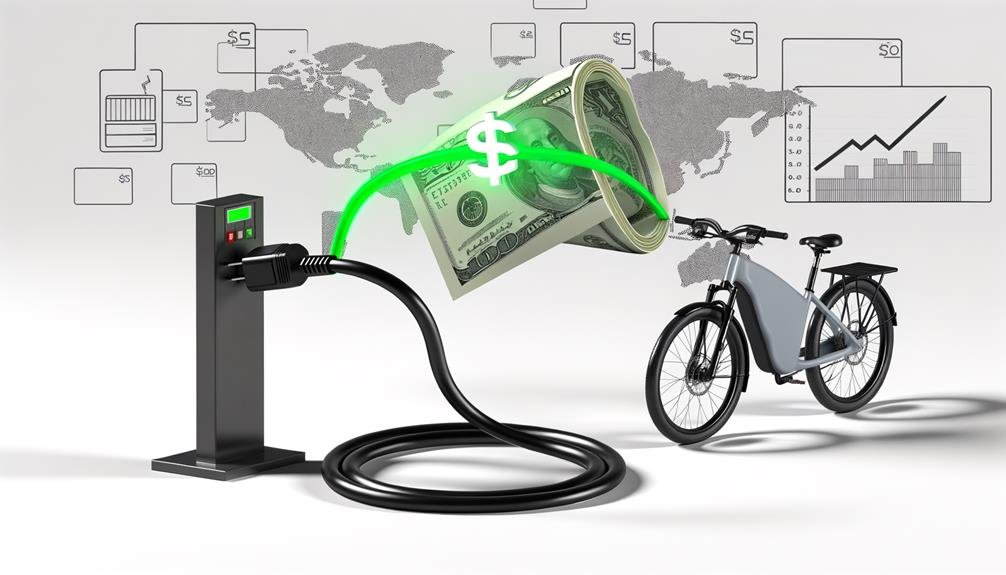Charles Miller is a veteran bike enthusiast with over 12 years of experience dealing with bikes as a mechanic. Despite immense love and expertise for...
As we embrace the eco-friendly trend of electric bikes, one question persistently pops up: where can we charge our e-bikes?
From the comfort of our homes to public spaces, charging stations for electric bikes are becoming increasingly common, yet they remain unknown to many riders.
It's not just about finding a place to plug in; we need to consider the time it takes, the cost, and even the safety of our bikes while they're charging.
So, let's embark on a journey to uncover the best locations and strategies to charge an electric bike, shall we?
- Key Takeaways
- Locating E-Bike Charging Stations
- Road-Trip Charging Strategies
- Understanding Charging Station Varieties
- Smartphone Apps for Charging Points
- E-Bike Charging Preparations
- Home-Based Charging Solutions
- Solar-Powered E-Bike Charging
- Cost Implications of E-Bike Charging
- Frequently Asked Questions
- Conclusion
Key Takeaways
- Charging stations for e-bikes can be found at restaurants, offering convenience for riders.
- Smartphone apps or printed maps can help locate the nearest charging spots.
- Lockers for e-bike batteries and charging points with power outlets provide safety and faster charging times.
- Bringing a compatible charging cable is important as there is no uniform standard across all stations.
Locating E-Bike Charging Stations
When we're on the road with our e-bikes, locating charging stations can be as easy as stopping for a meal at a restaurant, as many now offer this convenient feature. It's a perfect way to find the nearest charging site while enjoying some downtime. Just remember to bring your own charging cable for compatibility, as there isn't a uniform standard across all stations.
Locating e-bike charging stations goes beyond restaurants, though. With the help of smartphone apps or printed maps, we can pinpoint the nearest charging spots. Some apps may not show all existing stations, so having a physical map can be a reliable backup.
To ensure our e-bikes are safe while charging, we might consider using lockers for e-bike batteries and charging points with power outlets. These offer protection from theft and faster charging times. As we're charging, it's crucial to follow the manufacturer's recommendations and adopt the best charging practices. This way, we preserve battery life and performance, ensuring our e-bikes are ready for the next adventure.
Locating e-bike charging stations needn't be a chore. With some planning and the right tools, we can make the most of our e-bike journeys.
Road-Trip Charging Strategies
Building on our knowledge of locating e-bike charging stations, let's now turn our attention to smart strategies for charging our e-bikes during road trips. It's crucial to prepare ahead for any road trip, and the same goes when planning where to charge your electric bike.
Here are some effective road-trip charging strategies we can use:
- We can use our charging breaks wisely. Why not combine them with a coffee or lunch stop? Many restaurants offer charging stations, allowing us to recharge both our bikes and ourselves simultaneously.
- Always remember to bring our e-bike battery charger and a charging cable, as not all charging stations follow the same standard.
- Security is important. We can use lockers for our e-bike battery and charging cable during charging, ensuring they're safe and secure.
- Lastly, we can use a bike app. These applications show charging points and even allow navigation to them. It makes locating charging stations during our trip a breeze.
With these strategies, we'll never have to worry about how and where to charge our electric bikes on the road. Safe travels and happy charging!
Understanding Charging Station Varieties

Diving into the world of electric bike charging stations, it's key to understand that there's a wide variety of options available, each offering unique features and benefits. To effectively charge your electric bike, it's essential to familiarize yourself with these charging station varieties.
Lockers for e-bike batteries and charging cables offer theft protection, requiring you to remove your battery. Alternatively, bicycle stands with power outlets enable direct charging without the need to remove the battery. These are often found in public buildings, contributing to a robust charging infrastructure.
There are also versatile charging points with one or more power outlets. These stations accommodate both e-bikes and e-cars, reducing waiting times. For those seeking an easy charging experience, bike-energy charging points offer waterproof and compatible cables.
Notably, some charging stations are powered by solar panels. These provide an environmentally-friendly option, aligning perfectly with the green ethos of e-bike usage.
Smartphone Apps for Charging Points
We'll now discuss the role of smartphone apps in locating charging points for your electric bikes.
It's crucial to understand the features and limitations of these apps as they may not always provide the most accurate or comprehensive information.
We'll also compare some popular apps, helping you to choose the most suitable one for your needs.
Popular Charging Apps
In the world of electric bikes, there are several popular smartphone apps that can help you locate charging points, manage your charging sessions, and even read reviews from other users.
- PlugShare: This app shows available charging stations for both e-bikes and electric cars, providing real-time information and user reviews.
- ChargePoint: Offers a vast network of electric vehicle charging stations, including those suitable for charging e-bike batteries.
- Electromaps: Designed to locate electric vehicle charging stations with detailed information on payment methods and charging power.
- Open Charge Map: Provides a global database of charging stations, allowing users to locate, add, and review stations.
- eCharge: Focuses on providing information on e-bike charging stations, with user reviews and easy navigation to the nearest available stations.
These popular charging apps make it easier than ever to charge an e-bike.
App Features Comparison
Having explored the most popular apps for charging e-bikes, let's now compare their features to see how they stack up against each other. We've considered factors such as real-time monitoring of charging stations, distinguishing between e-bike and e-car points, and providing accurate, updated information.
| Features | Importance |
|---|---|
| Real-Time Monitoring | Allows planning, saves time |
| Differentiation (e-bike vs e-car) | Prevents confusion, wasted time |
| Accurate, Updated Information | Avoids unnecessary detours |
| Navigation to Nearest Station | Ensures easy access to charging points |
| Filtering Options | Helps choose based on cost, availability, and compatibility |
In our app features comparison, these factors are crucial for those who frequently ask “Where can I charge my electric bike?” They make the e-bike charging process smooth, efficient and hassle-free.
E-Bike Charging Preparations

Properly preparing to charge your e-bike can make all the difference, ensuring a smooth and uninterrupted ride. E-bike charging preparations aren't just about plugging in your bike; it's about planning and making the right choices.
Before you charge your e-bike battery, consider the following:
- Plan your route around charging stations; remember charging can take 3-5 hours. Use this time to grab a meal or coffee.
- Always bring your own charging cable. Not all stations use the same standard.
- Use a bike app for locating charging points and navigation. Have a printed map as a backup.
- Be aware of different types of charging stations – lockers, bicycle stands, bike-energy stations, and solar-powered stations.
- Good preparation can save you from unnecessary breaks. Consider a GPS tracker, and look at commercial/municipal locations for charging. Also, think about weather protection during battery charging.
Home-Based Charging Solutions
Turning to home-based charging solutions, it's worth investing in a dedicated e-bike charging station for reliable and straightforward battery management. This allows us to charge our electric bikes in a convenient and consistent manner. A dedicated station enables us to keep our batteries ready for use at all times, eliminating the worry of running out of charge when we need it the most.
A wall-mounted charging station is a great choice for those of us with limited space, keeping our e-bikes neatly parked while they charge. For those of us who like to move around our home or have multiple electric bikes, consider purchasing additional chargers. These can be placed in various locations, providing flexibility and convenience in charging our e-bikes.
For the eco-conscious among us, solar-powered charging solutions are an excellent way to harness renewable energy for our e-bike battery needs. Not only does this reduce our carbon footprint, it also adds an element of sustainability to our home-based charging solutions.
Ultimately, how we charge our electric bikes at home depends on our individual needs and preferences, but these solutions provide options for everyone.
Solar-Powered E-Bike Charging

Let's now turn our attention to solar-powered e-bike charging.
We'll explore what this type of charging entails, its unique benefits, and how to effectively implement such green energy solutions.
This discussion will offer us insights on how this sustainable method contributes to the broader e-bike charging infrastructure.
Understanding Solar-Powered Charging
Harnessing the power of the sun, solar-powered charging offers an eco-friendly and cost-effective way to juice up our e-bikes. Understanding solar-powered charging is essential to making the most of this renewable energy source. Here's what we need to know:
- Solar-powered charging stations use sunlight, converted into electricity by solar panels, to charge your bike.
- Portable photovoltaic panels can charge your electric bike anywhere under the sun, giving you freedom from traditional charging stations.
- A range of places from bars to homes offer solar charging, expanding our options significantly.
- Solar charging is highly efficient, minimizing energy loss during the charging process.
- The cost and potential savings of solar charging make it a wallet-friendly choice for powering our e-bikes.
Join us in embracing solar-powered e-bike charging.
Benefits of Solar Charging
Diving into the benefits of solar charging for electric bikes, we find it's not only environmentally friendly, but also offers off-grid charging, cost savings, portability, and the use of a renewable energy source.
By choosing solar charging, we actively reduce our carbon footprint, aligning our actions with our values of sustainability. We also unlock the liberty of charging our e-bikes anywhere with sunlight, freeing us from the constraints of traditional infrastructure.
The lifelong savings are significant, as the power of the sun doesn't come with a monthly bill. Portable solar chargers further add a layer of convenience, enabling us to energize our e-bikes on-the-go.
Investing in a solar charger isn't just an economic decision, but a commitment to renewable energy, fostering a sense of community among e-bike riders.
Implementing Solar Energy Solutions
Turning to the implementation of solar energy solutions, we find that solar-powered e-bike charging not only reduces our environmental impact but also provides a sustainable and cost-effective energy source for our electric bikes.
We can harness the power of direct sunlight to charge an Electric bike's lithium-ion batteries. Here are some key points to consider:
- Solar-powered e-bike charging stations offer an eco-friendly way to recharge.
- You can find solar charging points at various locations.
- Implementing solar energy solutions promotes sustainable transport options.
- We can reduce reliance on traditional grid power through solar charging.
- Solar charging is cost-effective, reliable, and convenient.
Join us in embracing these solar solutions and let's make our e-bike usage more sustainable and efficient.
Cost Implications of E-Bike Charging

When it comes to the cost implications of charging e-bikes, it's important to note that the process is often very affordable, or even free, depending on the location and methods used. It's generally the electricity price and the battery's capacity that determine the cost to charge the e-bike.
Many find charging at places like bars, restaurants, or even private homes to be cost-effective. In some cases, these locations provide free charging, making the process gentler on your wallet. Always remember to ask for permission before you plug in your ebike charger.
Furthermore, for those of us who love outdoor adventures, portable photovoltaic panels are a sustainable and cost-efficient way to get your e-bike fully charged. It's an earth-friendly solution that aligns with our shared values of sustainability and cost efficiency.
Also, we should bear in mind that using chargers with a maximum of 4 Ah and opting for slow charging can help extend the lifespan of our e-bike batteries. This approach can potentially reduce long-term costs, contributing to the overall cost implications of e-bike charging. This way, we not only save money but also maintain the health of our beloved e-bikes.
Frequently Asked Questions
Can You Charge an E-Bike at a Charging Station?
Yes, we can charge e-bikes at charging stations. We've got to consider station accessibility, types, charging speed, and safety. It's essential we use compatible chargers and follow safety guidelines for a successful charge.
Can We Charge Electric Bike Anywhere?
"We're not magicians, but we can charge electric bikes almost anywhere! With portable chargers, outdoor charging is possible. Just remember, for battery lifespan and safety, follow precautions and manufacturer guidelines."
Where Can I Charge My Ebike Battery?
We can charge our e-bike batteries at restaurants, home, or on the go using portable chargers. Solar charging is eco-friendly, while fast charging options boost battery longevity. Let's keep our rides powered up together.
What Is the Cost of Charging an Electric Bike?
We're often asked about the cost of charging an electric bike. Factoring in electricity pricing, bike efficiency, and power consumption, it's typically quite low, often just cents per charge depending on your local charging infrastructure.
Conclusion
In conclusion, we've journeyed through the endless possibilities for charging your e-bike. From clever apps to solar-powered solutions, it's clear that we're living in a golden age of e-bike charging options.
So, don't let a depleted battery slow your roll. Armed with our advice, you're now more than equipped to conquer any charging challenge that comes your way.
Remember, a well-charged e-bike is your ticket to exploring the world in eco-friendly style.

Charles Miller is a veteran bike enthusiast with over 12 years of experience dealing with bikes as a mechanic. Despite immense love and expertise for his Tacoma, he rides his Trek Ebike more. Anytime you meet him, you’ll either hear him talking about Bikes, or writing about all things bikes and cars on this blog.
More Posts


